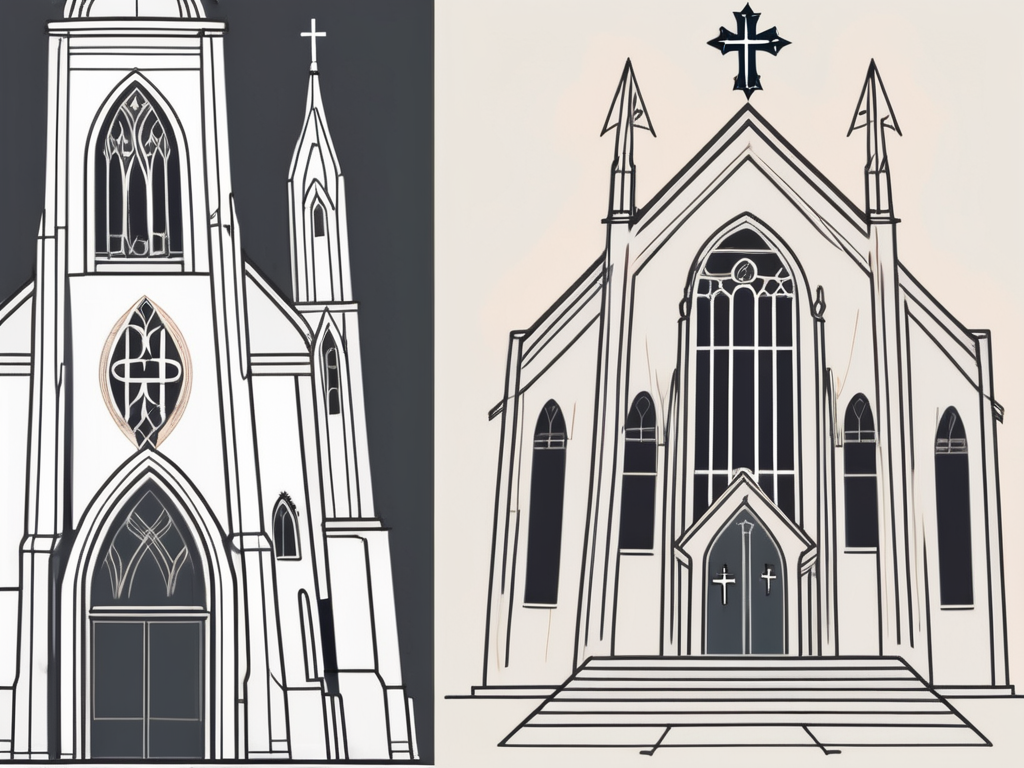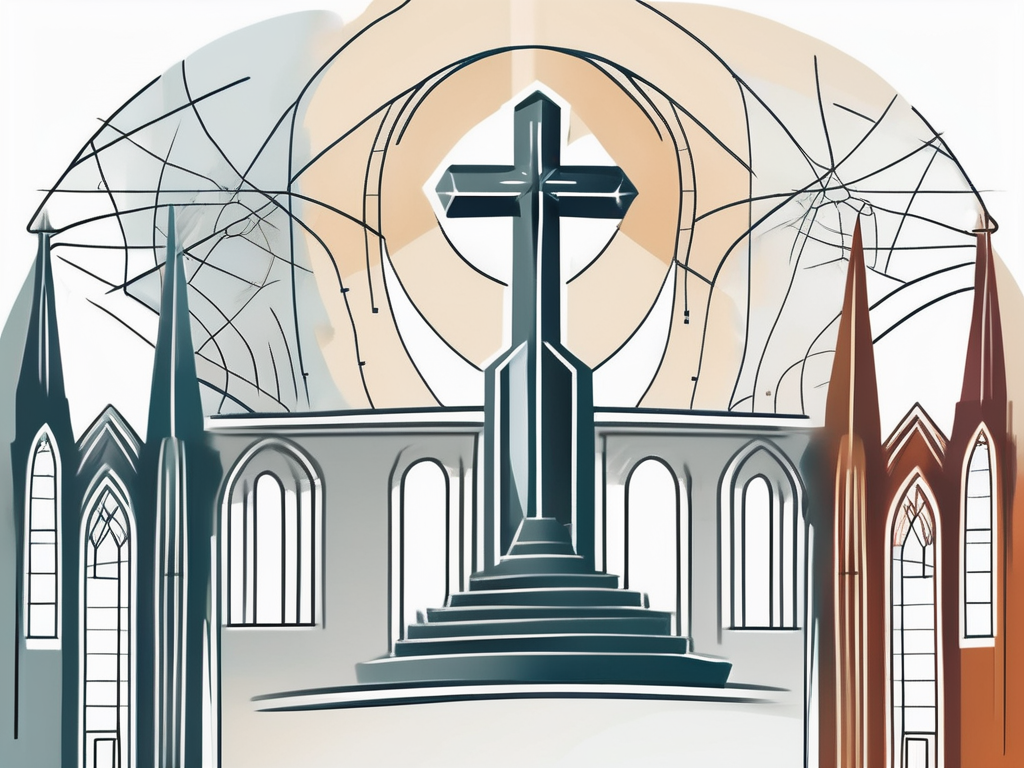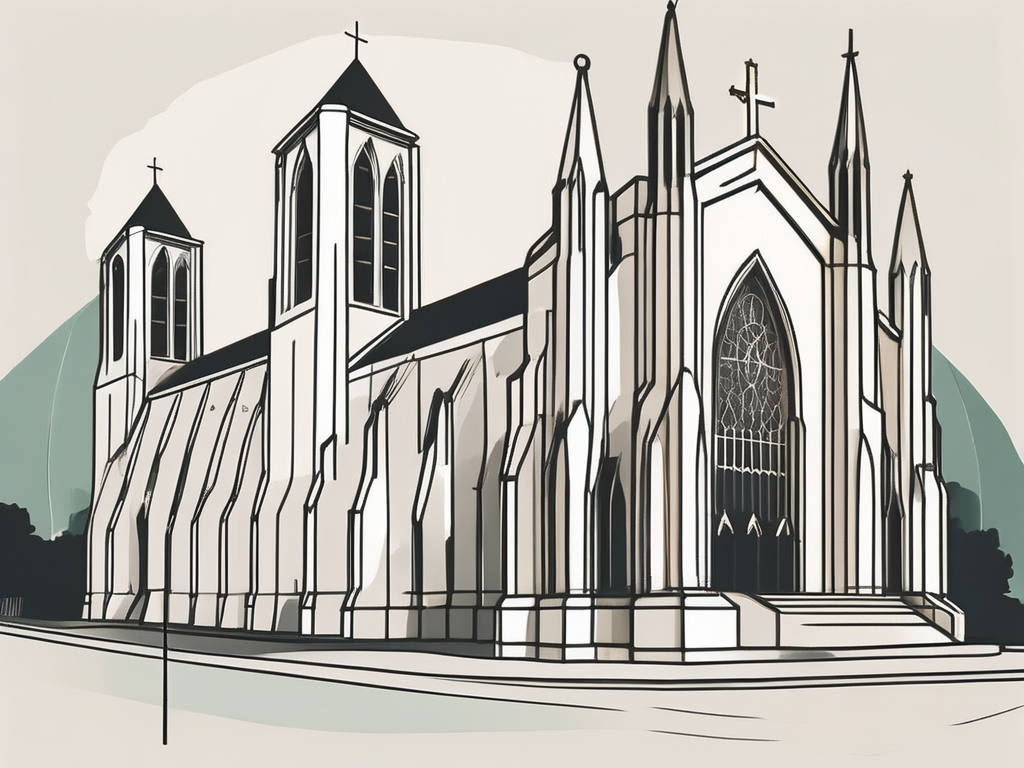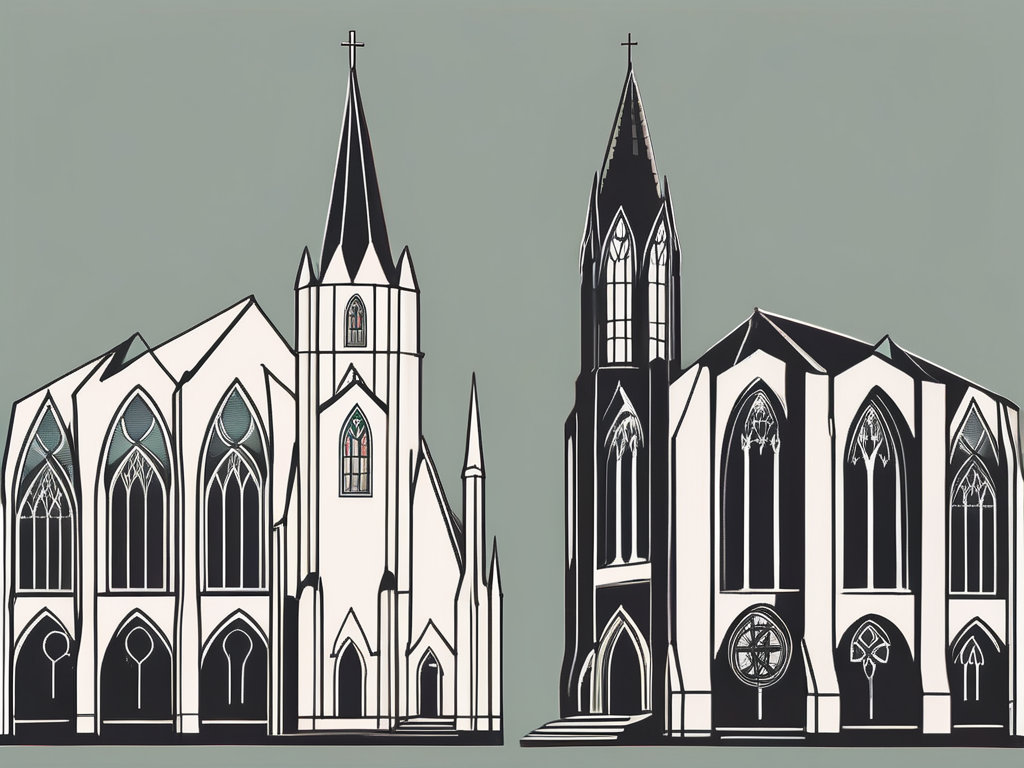Have you ever wondered about the differences between the Anglican and Methodist churches? These two Protestant denominations have a rich history and a significant impact on society. In this article, we will dive deep into their origins, beliefs and practices, organizational structures, role of clergy, and social and cultural impact. By the end, you’ll have a better understanding of these two Christian traditions and how they compare to each other.
Understanding the Origins
Before examining their differences, let’s explore the fascinating stories of how Anglicanism and Methodism came to be.
The Birth of Anglicanism
Anglicanism traces its roots back to England in the 16th century. It all began when King Henry VIII sought to dissolve his marriage and establish himself as the head of the Church in England. This led to the break from Rome and the creation of the Church of England, with the monarch at the helm.
However, the origins of Anglicanism are not solely rooted in political motivations. The Reformation sweeping across Europe during this time also played a significant role in shaping the new religious landscape in England. Influenced by Protestant ideas, the Church of England embraced key principles such as the authority of Scripture and the belief in salvation by faith alone.
Over the centuries, Anglicanism evolved into a diverse denomination with a wide range of practices and beliefs. From the high church aesthetics of traditions like Anglo-Catholicism to the evangelical zeal of the low church movement, Anglicanism offers a spectrum of worship styles and theological perspectives.
The Emergence of Methodism
Methodism, on the other hand, emerged in the 18th century as a religious movement within the Church of England. Considered a reform movement, it was led by John Wesley, an Anglican preacher, and his brother Charles Wesley.
The Wesley brothers, along with their followers, sought to renew the spiritual vitality of the Church of England. They emphasized personal piety, passionate preaching, and a methodical approach to spiritual growth, which earned them the nickname “Methodists.” Their movement quickly gained popularity, attracting people from various social backgrounds who were seeking a deeper, more experiential faith.
One of the distinctive features of Methodism was its emphasis on social justice and activism. John Wesley, in particular, was deeply committed to addressing the social issues of his time, such as poverty and inequality. He believed that faith should not be confined to the walls of the church but should be lived out in practical ways, making a positive impact on society.
Eventually, Methodism grew into a separate denomination with its own identity and denominational structure. It spread beyond England, finding fertile ground in the American colonies and other parts of the world. Today, Methodism continues to be a vibrant and influential branch of Christianity, known for its emphasis on personal holiness, social engagement, and vibrant worship.
Core Beliefs and Practices
Now, let’s delve into the core beliefs and practices that differentiate Anglicanism from Methodism.
Anglicanism and Methodism are both Christian denominations that share some similarities but also have distinct differences in their doctrine and worship practices.
Anglican Doctrine and Rituals
Anglicanism finds its theological foundation in the Bible, the creeds of the early Church, and the teachings of the early Christian theologians. The Anglican Communion encompasses a diverse range of theological perspectives within its broad tent, allowing for a variety of interpretations and practices.
Tradition plays a significant role in Anglican worship, with liturgy and sacraments central to their practice. Anglicans believe in the sacraments of baptism and Holy Communion, which are seen as means of grace and channels through which believers can experience the presence of God.
Anglican liturgy is known for its beauty and reverence, often incorporating ancient prayers, hymns, and rituals. The Book of Common Prayer, first published in 1549, is a foundational text for Anglican worship and provides a framework for the celebration of the Eucharist, daily prayers, and other religious ceremonies.
Anglicans value the importance of community and the role of the Church in guiding believers in their spiritual journey. The role of the clergy, including bishops, priests, and deacons, is seen as crucial in providing pastoral care, administering sacraments, and leading worship.
The Anglican Communion allows for a range of theological perspectives within its broad tent. The denomination encompasses both conservatives who adhere closely to traditional teachings and progressives who embrace social justice initiatives and modern interpretations of scripture.
Methodist Theology and Worship
Methodism, on the other hand, emerged as a distinct movement within Anglicanism in the 18th century. It places a strong emphasis on personal faith and a belief in salvation through grace. Methodists believe that salvation is a gift from God and that it can be received through faith in Jesus Christ.
Methodists also believe in the authority of scripture, considering it the primary source of religious authority and guidance. They emphasize the importance of personal conversion, an individual’s decision to turn to God and accept Jesus Christ as their savior.
Methodism places a significant emphasis on the pursuit of holiness in everyday life. Methodists believe in the concept of “sanctification,” the process of becoming more Christ-like in character and conduct. This includes acts of love, justice, and mercy towards others.
Methodists value lively worship, heartfelt hymn singing, and communal prayer. They often engage in enthusiastic singing and clapping during worship services, expressing their joy and gratitude for God’s grace. The sermon plays a central role in Methodist worship, with preachers delivering messages that aim to inspire, challenge, and encourage spiritual growth.
Methodism emphasizes practical Christianity and social outreach, leading to the establishment of many Methodist hospitals, schools, and social service organizations. This emphasis on social justice continues to shape the denomination’s identity and mission. Methodists believe that faith should be lived out in action, and they actively seek to address societal issues such as poverty, inequality, and injustice.
In conclusion, while both Anglicanism and Methodism are Christian denominations that share a common heritage, they have distinct beliefs and practices that set them apart. Anglicanism places a strong emphasis on tradition, liturgy, and sacraments, while Methodism emphasizes personal faith, social holiness, and practical Christianity.
Organizational Structure
Next, let’s explore how Anglicanism and Methodism are organized at a structural level.
The Hierarchical System of Anglicanism
Anglicanism follows a hierarchical structure, with the Archbishop of Canterbury serving as the symbolic head of the Anglican Communion. The position of the archbishop holds great significance, as they are considered the spiritual leader and representative of the Anglican Church worldwide. They play a vital role in promoting unity and fostering dialogue among the different autonomous churches within the Anglican Communion.
Below the archbishop, bishops oversee individual dioceses, which are geographical regions within the church. They are responsible for providing pastoral care, guidance, and oversight to the clergy and congregations within their diocese. Bishops are ordained leaders who carry the authority to ordain priests and deacons, administer sacraments, and make decisions on matters of faith and doctrine.
Priests, also known as rectors or vicars, lead local parishes and are responsible for the spiritual well-being of their congregations. They conduct worship services, administer sacraments, provide pastoral care, and offer guidance and support to their parishioners. Priests play a crucial role in fostering a sense of community and nurturing the spiritual growth of their congregations.
Deacons, on the other hand, assist in various ministries within the Anglican Church. They are ordained to a distinct order of ministry and are often involved in outreach programs, social justice initiatives, and community service. Deacons bridge the gap between the church and the wider society, bringing the message of love and compassion to those in need.
This hierarchical structure provides a sense of unity and accountability within the Anglican Church. It ensures that there is a clear line of authority and responsibility, allowing for effective governance and decision-making.
Furthermore, the Anglican Communion is an international body, with autonomous churches in different countries. This global network allows for a rich cultural diversity and theological dialogue. It provides opportunities for Anglicans from various backgrounds to come together, share their experiences and perspectives, and learn from one another. The Anglican Communion fosters a sense of global solidarity among its member churches, promoting collaboration and cooperation in addressing common challenges and advancing the mission of the church.
The Connectional System of Methodism
Methodism, in contrast, adopts a connectional system where authority is distributed across various levels of the church. This system is rooted in the belief that the church is a community of believers who are interconnected and interdependent.
At the local level, individual congregations are led by pastors, also known as ministers or preachers, who are appointed by the denomination. Pastors are responsible for providing spiritual leadership, preaching the Word of God, administering sacraments, and guiding the faith community. They work closely with a board of lay leaders, who are elected by the congregation and assist in the governance and decision-making processes of the church.
Regional conferences, also known as districts or circuits, provide oversight and support to the local congregations within their jurisdiction. They are led by superintendents, who are ordained ministers appointed by the denomination. Superintendents ensure that the churches within their region are functioning effectively, provide pastoral care to the pastors and their families, and facilitate collaboration and cooperation among the congregations.
The General Conference serves as the highest decision-making body for the Methodist denomination. It is composed of elected representatives from the regional conferences and is responsible for setting the direction, doctrine, and policies of the denomination. The General Conference meets every few years to discuss and make decisions on various matters, including social issues, theological debates, and organizational structure.
This connectional structure enables Methodists to emphasize cooperation and shared decision-making in their faith communities. It fosters a sense of collective responsibility and encourages the active participation of lay members in the life of the church. Methodists believe that by working together, they can better fulfill their mission of spreading the love of Christ and transforming the world.
Role of Clergy
The role of clergy in these two denominations also differs significantly. Let’s explore that now.
Clergy in the Anglican Church
In Anglicanism, the clergy play a central role in leading worship, administering sacraments, and providing pastoral care. Bishops have the authority to ordain priests and deacons, and they are responsible for the spiritual oversight of their dioceses. Priests, in turn, serve as the spiritual shepherds of local parishes, while deacons focus on ministry outside of the church walls.
Anglican clergy are typically trained in seminaries and receive theological education, equipping them for their pastoral roles.
Clergy in the Methodist Church
Methodism has a more egalitarian approach to clergy. While pastors hold important leadership roles, they are considered equal members of the community alongside laypeople. Methodism values the “priesthood of all believers,” emphasizing the ministry of all believers, not just the ordained clergy.
Methodist clergy also undergo theological education and training but are often encouraged to empower lay leadership and involve the congregation in decision-making processes.
Social and Cultural Impact
Lastly, we’ll explore the social and cultural impact that Anglicanism and Methodism have had over the years.
Anglicanism’s Influence on Society and Culture
Anglicanism has historically been deeply intertwined with politics and society. The Anglican Church played a significant role in shaping British identity, as well as in the spread of the English language and literature. Many iconic cathedrals and parish churches stand as reminders of the Anglican legacy and architectural brilliance.
Apart from its historical contributions, Anglicanism continues to engage with social issues, such as religious freedom, poverty, and environmental stewardship, through various initiatives and organizations.
Methodism’s Role in Social and Cultural Movements
Methodism, with its focus on personal piety and social justice, has had a profound impact on social and cultural movements. Methodists played influential roles in the abolition of slavery, the women’s suffrage movement, and the civil rights movement in the United States.
Today, Methodists continue to be actively involved in humanitarian efforts, advocating for equality, inclusivity, and the well-being of marginalized communities all over the world.
Conclusion
In conclusion, while both the Anglican and Methodist churches fall under the Protestant umbrella, they possess distinct characteristics and traditions that set them apart. From their origins and beliefs to their organizational structures and social impact, each denomination offers a unique flavor of Christianity.
Whether you find solace in the rich symbolism of Anglican worship or resonate with the Methodist emphasis on personal faith and social justice, these two denominations demonstrate how Christianity can adapt across different cultures and historical contexts to touch the lives of millions of people.












